New-generation offshore floaters are coming on stream to drill and produce oil and gas under extreme environments, including the Lower Tertiary plays in the Gulf of Mexico and the presalt finds in deepwater Brazil.
Pramod Kulkarni, Editor
“Follow the money” is a good rule to understand complicated financial activities. In the oil and gas industry, you can gauge trends by following the newbuilds. Since 2009, many newbuilds in floating structures—drillships, spars and FPSOs—have headed to either the ultra-deepwater Lower Tertiary plays in the Gulf of Mexico or deepwater fields in Brazil. As the focus in these areas is on the long-term results, ultra-deepwater operators and their drilling contractors and EPC partners did not slow down to catch their breath during the oil price dip and have been introducing newbuilds at a rapid pace. The design criteria for the floating structures are to provide stability in 10,000 ft of water, and for modular offshore drilling units (MODUs) to be able to drill to 40,000 ft, typically with sixth-generation drilling units. Mooring advances are keeping pace with lighter polyester ropes and more efficient deployment methods.
DRILLSHIPS
Since 2009, the major drilling contractors have been vying with each other in launching newbuilds capable of ultra-deepwater operations. Many of these feature Class III dynamic positioning (DP) capabilities for maintaining drilling position under rough sea states and sixth-generation drilling technology. Sixth-generation technology facilitates multi-tasking drilling, testing and workover operations with less rigsite staff.
In March, Transocean’s newbuild Discoverer Inspiration began deepwater drilling operations under contract to Chevron, Fig. 1. This follows the contractor’s two drillship deployments in 2009 in the Gulf of Mexico: Discoverer Americas, under contract to Statoil, and Discoverer Clear Leader, working for Chevron. Transocean’s Enterprise-class, double-hulled drillships feature patented dual-activity drilling technology, which allows for parallel drilling operations. The vessels are capable of drilling to 40,000-ft total depth in 10,000-ft water depth with an enhanced 1,250-ton top drive system and a high-pressure mud system. The 835-foot-long ships can accommodate 200 personnel and can move between locations at up to about 12 knots using their own power and six thrusters. Transocean’s Discoverer Deep Seas set the world water-depth record of 10,011 ft while working for Chevron in the US Gulf of Mexico. Transocean has three additional newbuild ultra-deepwater floaters expected to commence operations in 2010 and 2011. Two of these vessels, the Discoverer India and the Discoverer Luanda, are also Enterprise-class drillships. The other unit is the drillship Deepwater Champion, which will commence drilling for ExxonMobil in the Black Sea.
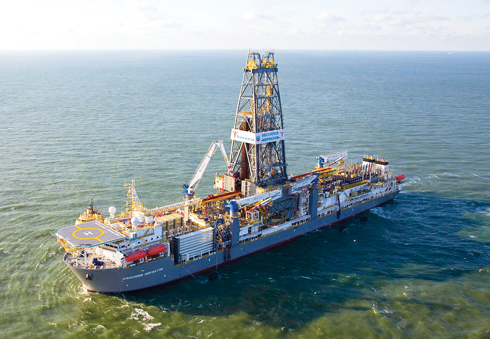 |
|
Fig. 1. Transocean’s Discoverer Inspiration is the latest drillship to commence ultra-deepwater drilling in the Gulf of Mexico.
|
|
In late February, Pride International announced the dedication of the first of its four new deepwater drillships under construction by Samsung in South Korea, the Deep Ocean Ascension. The vessel will commence operations in the third quarter of the year under a five-year contract with BP. The next drillship to be delivered for Pride is the Deep Ocean Clarion, with an expected August 2010 completion date, followed by the Deep Ocean Mendocino in the first quarter of 2011, and the Deep Ocean Molokai in the fourth quarter of 2011.
Pacific Drilling, a new contender in the ultra-deepwater market, has its first drillship, Dhirubhai Deepwater KG2, drilling offshore India for Reliance Industries. The company’s second newbuild, Pacific Santa Ana, is currently under construction in South Korea. Equipped with dual-gradient drilling technology, the Pacific Santa Ana will operate in deepwater Gulf of Mexico for Chevron. Pacific has four other ultra deepwater vessels under construction for launch during 2010–11.
SEMISUBMERSIBLES
In March 2010, Diamond Offshore launched two submersible newbuilds: Ocean Valor and Ocean Courage. Both are sixth-generation DP rigs capable of drilling in 10,000-ft water depth to a formation depth of 40,000 ft. The vessels were purchased in late 2009 out of the bankruptcy of Petromena ASA of Norway. Both vessels will be under contract to Petrobras for drilling offshore Brazil. In December 2009, Transocean’s semisubmersible rig Development Driller III (Fig. 2) commenced operations in the Gulf of Mexico for BP. The rig has a motion-compensated winch capable of deploying subsea assemblies to the seabed, a high-pressure mud-pump system, and variable deck load of 7,000 metric tons (mt).
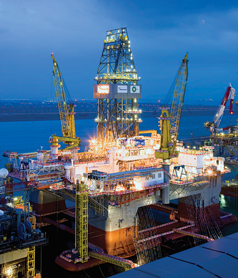 |
|
Fig. 2. Transocean’s semisubmersible Development Driller III is drilling for BP in the Gulf of Mexico.
|
|
SPARS
The multipurpose floating structure currently in vogue for ultra-deep water is the spar. With its cylindrical hull and deep draft design, the spar is stable and can remain afloat even with damage to multiple tanks. The spar does not derive its stability through mooring. Instead, stability is achieved by separating the structure’s center of gravity and the center of buoyancy. The center of gravity is lowered by installing heavy ballast at the platform keel.
The first modern spar was the Neptune platform installed in 1996. Since then, the classic spar concept has evolved with the introduction of the truss spar and the cell spar. A truss spar is capable of operating in more severe environments due to exchange of the mid-section of the classic spar for a truss section with plates designed to reduce heave motion. Since the Neptune, deepwater operators in the Gulf of Mexico have built more than a dozen spar floaters. The latest of these floaters is the Shell Perdido truss spar (Fig. 3), located at a record 7,800 ft in ultra-deep water. Supporting drilling and production for Great White, Tobago and Silvertip Fields, the regional host facility became operational in late March. In the international arena, Kikeh Field offshore Malaysia is being produced using both a spar floating structure and an FPSO.
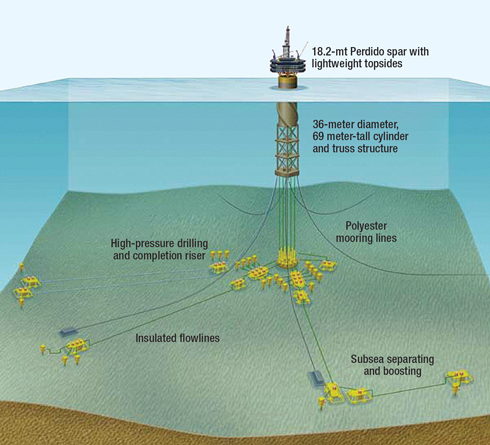 |
|
Fig. 3. The Shell Perdido spar is located at a record 7,800 ft in ultra-deep water of the Gulf of Mexico. Courtesy of Shell.
|
|
At the Perdido spar, several subsea wells are within the offset circle of the platform. Vertical import risers will be used to commingle production from these wells. Direct vertical access (DVA) for drilling or workover operations will be achieved by winching the platform to line up the rig with the subsea well. It is also possible to perform offset drilling by winching the spar a sufficient distance to allow a MODU access to the well.
Both Technip and FloaTEC have developed conceptual designs for spars adapted for other offshore regions of the world, including the Arctic Barents Sea and East Canada. The Arctic Spar design has a disconnectable two-piece hull. In case of an approaching ice floe or extreme storm, the upper hull can be towed away to safety, Fig. 4. The keel buoy can remain connected to the risers and submerged on location.
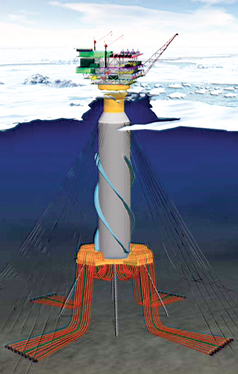 |
|
Fig. 4. FloaTEC’s concept for an Arctic spar.
|
|
FPSO
FPSOs are fast becoming the primary mode for offshore production, storage and offloading throughout the world because of the relatively lower upfront capital cost and ease of relocation as compared to fixed platforms. In fact, Petrobras President José Sergio Gabrielli de Azevedo has projected that the operator will require eight FPSOs to reach the target of producing 1.8 million bopd from presalt fields by 2020 and as many as 30 FPSOs by 2030.
In March 2009, Modec’s FPSO Cidade de Niteroi MV18 produced first oil from the Jabuti reservoir in the Campos Basin’s Marlin East Field, Fig. 5. The FPSO is spread-moored at 1,400-m water depth. The vessel is capable of processing 100,000 bopd with a gas compression capacity of 124 MMcfd and oil storage capacity of 1.6 million barrels. This is Modec’s fourth FPSO working offshore Brazil. The company is building two additional FPSOs for Petrobras and its partners: Cidade de Santos MV20, which will be deployed in Urugua Field and will also gather production from Tambau Field, and the Cidade de Angra dos Reis MV22, which is the pilot FPSO for the presalt Tupi Field in the Santos Basin.
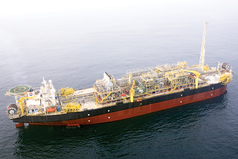 |
|
Fig. 5. Modec’s FPSO Cidade de Niteroi MV 18 is operating in the Campos Basin.
|
|
Petrobras will introduce the first FPSO to the Gulf of Mexico in mid-2010 when it will start producing from its Lower Tertiary Chinook and Cascade Fields. An FPSO production scheme was necessary because the fields are 160 miles from shore and away from existing export pipeline networks. The FPSO BW Pioneer (Fig. 6) is capable of processing 80,000 bopd and 16 Bcfd of gas and can store nearly 500,000 bbl of oil. The vessel will be moored in 8,200 ft, deepest to date for an FPSO. In the first phase of the project, production from two wells in Cascade Field and one well in Chinook Field will be connected to the vessel. In the second phase, seven more wells from Chinook Field and another seven wells from Cascade Field will be added. Designed to handle the harsh operating conditions in the ultra-deep Gulf of Mexico, the BW Pioneer is equipped with an internal disconnectable submerged turret production mooring system and outfitted with safety features to withstand environmental loads from currents, waves, and wind. When a hurricane approaches, the disconnectable turret will allow the FPSO to disengage from site and move on its own propulsion to an evacuation site.
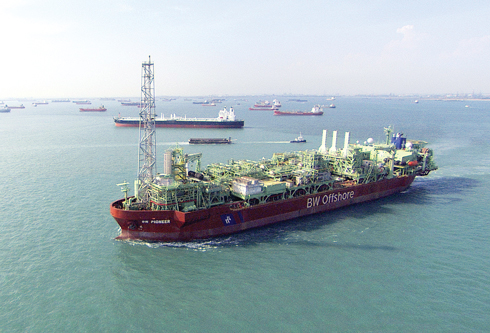 |
|
Fig. 6. The Petrobras BW Pioneer leaves Singapore for the Chinook/Cascade Fields in the Gulf of Mexico.
|
|
Aker Floating Production has introduced a “Smart FPSO” concept that stresses rapid deployment within 18–22 months to accelerate the production of first oil. Aker has purchased three Suez-max oil tankers for this purpose. The company delivered its first concept FPSO to Reliance Industries. Named Dhirubhai I, the vessel is stationed at MA-D6 Field on the east coast of India, Fig. 7. The FPSO has a processing capacity of 9 MMcfd and 60,000 bopd with total storage capacity of 1.3 million bbl of oil. As the FPSO is operating in an area of frequent typhoons, it has a disconnectable turret for temporary production shut-in and evacuation of the vessel to safer waters.
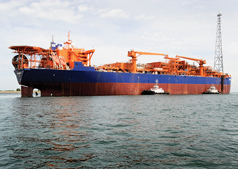 |
|
Fig. 7. Aker Floating Production’s FPSO Dhirubhai I is operating on the east coast of India for Reliance Industries.
|
|
CYLINDRICAL HULLS
Sevan Marine has developed a unique floating structure with a cylindrical hull. It is a geostationary, double-bottom, double-sided hull with low motion characteristics and stability reserves. The floater can be installed using conventional spread mooring with quick hookup to a pre-laid mooring system. In deepwater areas, it can be operated with steel catenary risers. The first unit, the Sevan Piranema, has been operating for Petrobras offshore Brazil since 2007. The Sevan Hummingbird and Sevan Voyageur are working in the North Sea. The latest hull, the Sevan Driller, will begin drilling for Petrobras in the presalt area, Fig. 8. The vessel is capable of drilling of wells up to 40,000 ft in water depths of up to 12,500 ft, with an internal storage capacity of up to 150,000 bbl of oil.
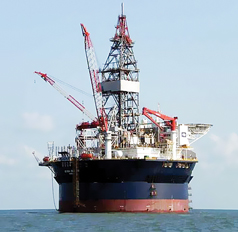 |
|
Fig. 8. The Sevan Driller arrived in Brazil waters late March to begin drilling in the presalt area.
|
|
SSP Offshore has also designed circular floaters, SSP and SSP Plus, that eliminate the need for an expensive turret and require less steel for storage capacity than a conventional FPSO. Both units were model tested at LabOceano in Brazil to confirm the large natural periods, low pitch and roll, and motion characteristics similar to a spar.
FLNG
FEED programs for two floating LNG liquefaction (FLNGs) are underway. Shell has signed contracts with Technip and Samsung for the Prelude floating liquefied natural gas (LNG) project off the coast of Western Australia. Additionally, Technip, in association with JGC and Modec, has been awarded by Petrobras the FEED contract of a proposed FLNG for the presalt reservoirs of the Santos Basin.
MOORING SYSTEM ADVANCES
In designing passive mooring systems for ultra-deepwater floaters, the challenge for operators and engineering contractors is to develop a cost-efficient system with relatively easy service requirements. The design is developed through the involvement of a metocean specialist to meet 100-year weather patterns, ocean current variations and swell conditions. Software numerical modeling is followed by wind tunnel and wave basin tests, if sufficiently large facilities are available. In Norway, Marintek’s Ocean Basin Laboratory, with a 10-m deep tank, facilitates total environmental simulation of all types of fixed and floating structures.
Polyester rope. Because of its light weight and high strength, polyester rope is being used increasingly in deepwater applications beyond 4,000 ft. For example, for the FPU Thunderhawk, SBM Atlantia, which designed the platform, selected polyester to achieve FPU motions that are more compliant and riser friendly. The Thunderhawk is anchored with a polyester rope-chain spread mooring system connected to 12 driven piles. For ultra-deep water (10,000 ft and beyond), InterMoor is working with rope vendors to develop blended/mixed mooring systems made up from multiple types of rope sections (e.g., polyester/Kevlar and polyester/aramid.)
Mooring line test bed. InterMoor and Halo have installed a test bed in Port Fourchon, Louisiana, capable of testing mooring lines up to 220-ft long with an 11-ft stroke that can apply a 3,000-kip pulling force, Fig. 9.
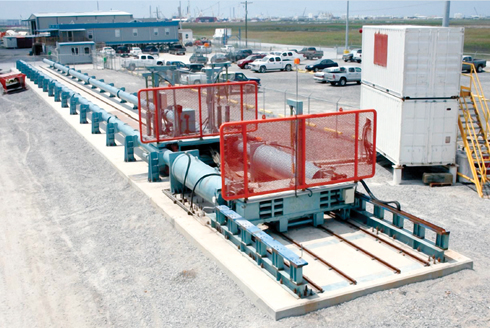 |
|
Fig. 9. The InterMoor/Halo test bed in Port Fourchon, La.
|
|
Compact suction anchors. Among the innovations in mooring anchor technology is the compact suction embedded plate anchor (SEPLA). Patented by InterMoor, the SEPLA anchor combines the advantages of the suction pile embedment at one-half to one-third the cost. InterMoor has installed the anchors offshore Angola for Chevron’s Tombua Landana tender-assisted drilling unit. The anchors are permanently installed for multiple reconnect operations during the life of the field.
ULTRA-DEEP AND BEYOND
Step by incremental step, floating structure and mooring advances have taken the oil and gas industry to yet another frontier: ultra-deep water. It will take a decade or more for the ultra-deep water to become a mature arena. Undoubtedly, the newbuilds of the future will make us scratch our heads to come up with a superlative beyond ultra. 
|











